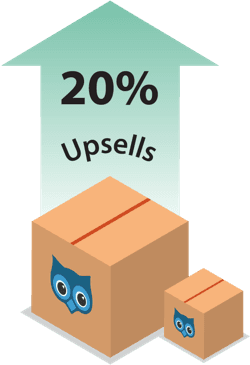
Do one-click upsells make you more money? (Yes!)
We analysed our data to find out
We launched one-click pre-payment and post-checkout upsells and cross-sells in March 2015. Now, we've crunched our data to see how much extra revenue they've been bringing in for our sellers. In this post we'll look at our results, as well as at what one-click upsells and cross-sells are, why you might use them and when you might use them.
We launched one-click pre-payment and post-checkout upsells and cross-sells in March 2015. Now, we've crunched our data to see how much extra revenue they've been bringing in for our sellers. In this post we'll look at our results, as well as at what one-click upsells and cross-sells are, why you might use them and when you might use them.
What are one-click upsells and cross-sells?
Upsells and cross-sells are a great way to get people to spend more money when they have already committed to a purchase. They are used all the time for physical goods: "do you want a drink with that" (cross-sell) or "the new version of that camera has wireless connectivity and a longer battery life: would you prefer to buy that?" (upsell).
Upsells and cross-sells, however, target people in slightly different ways. Upsells show people something more expensive and say: "why not have this great item instead?" These can be particularly effective if you have tiered pricing, and can persuade customers that by spending a little more they can get a product that is faster/smarter/more suited to their needs.
Cross-sells, in contrast, are about getting your customers to buy something in addition rather than something more expensive. Amazon are masters at cross-selling. Their 'frequently bought together' and 'customers who bought this item also bought' sections invite you to make additional, usually relevant, purchases. Amazon reports that as much as 35 percent of their revenue is from cross-selling.
This is how an upsell looks using SendOwl.

Why are one-click upsells and cross-sells so useful?
It's easy to focus on trying to get more customers to buy your product or service. After all, this is an important metric. However, it's expensive getting customers to come to your site, to stick around, to select buy now or add to cart, and then to follow through with their purchase.
So to make the most of your hard work, you want to make sure you maximise the lifetime value of that customer. This can mean either persuading them to spend more money or to buy from you more often. Or preferably both.
If you increase the lifetime value of your customers your business will grow in a satisfying way, even if your new customer acquisition rate is fairly modest. You want the lifetime value of your customers to look like this:

Upsells are an excellent way of persuading customers to spend more money, in a way that doesn't interfere with their initial purchase. This should be particularly true of post-checkout upsells, although interestingly these aren't noticeably favoured by our sellers (see below).
What seems to be more important than whether you offer a pre-checkout or post-checkout offer, is that you offer your customers something generally useful. So that they feel you are being thoughtful rather than annoying!
When would you use one-click upsells and cross-sells?
- You want to encourage people to buy a related digital product as well as the one they have already selected – perhaps the second book in a series or a complementary video
- You want to encourage people to choose a more expensive digital product when they have already got out their credit card and are prepared to spend money
- You want to offer people the chance to buy a higher value product or an extra product at a discount, which means more money for you and a good deal for the customer
- You want to offer extra goods but only once the buyer has entered their payment details and you know your initial sale is safe
Do one-click upsells and cross-sells really make you more money?
Yes. Our sellers made between 4% and 20% more revenue through one-click upsells and cross-sells. That's not a bad result considering how easy upsells are to set up (okay, maybe it takes 30 seconds to set up an upsell or cross-sell – hardly the labour of Hercules).
SendOwl seller Craig Clarke, founder of keto diet website Ruled.me and meal plan site Keto Academy, has found that his average order value has increased by about 20% after using upsells and cross-sells:
My results have been pretty great. I find that my average overall order value increased by about 20%. Over time this can add up to quite a lot of extra capital flowing into your business. I have upsells on all of my products. I've learned that if your customer is interested in your goods, and they're ready to pull out their credit card (or paypal account) to pay you for what you're offering - you might as well try to continue your sale for higher profit margins. This has resulted in just over 50% conversion rate in my upsells.
How do I make 20% extra rather than 4% extra?

Our research shows that power users of upsells are more likely to make 20% extra rather than 4%. In fact, we see a pretty straight line between the number of upsells by a seller and the % extra they make. So, success breeds success!
Be strategic and professional
A quick look at power users showed us some very professional websites like Colour Grading Central and Hands On as we grow. If people trust you and want to buy from you, they are more likely to consider giving you more money than they initially intended. So, to boost the revenue you get from upsells audit your site to check that your website is easy to use, professional and persuasive.
Craig also suggests that being strategic about testing and implementing upsells and cross-sells will pay dividends:
Make sure that you're not relying on only short term results to dictate a decision. If you're testing out certain upsells, make sure you have enough of a sample size to determine if it's working or not working. Also, don't try to upsell products that aren't related to each other. I think one of the reasons that my upsells do so well is that they add value to what I'm already selling. If a potential customer is in a buying state of mind, then an upsell of something related and useful to them is usually a pretty easy choice.
Consider offering a discount
Consider offering discounts to encourage people to spend more. That way, customers think they are getting a good deal too. So, you could offer customers a 10% discount on an ebook bundle, which would still make you more money, but sounds more attractive to a customer than simply saying 'why not spend an extra $40?'.
Add photos or videos
Think about adding a photo or video to your cross-sell or upsell to make it more attractive to customers. After all, you are asking them to spend money on a product they probably don't know much about. So a photo or video will give them an injection of information when they need it.
Do cross-sells or upsells work better?
Well, we can tell you which is more popular with our sellers. And presumably our sellers favour the option that brings them the most revenue.
Sellers with fewer successful upsells tend to favour upsells and cross-sells fairly equally. However, our power upsell users tend to overwhelmingly favour cross-sells.
Do pre-checkout and post-payment upsells work better?
Pre-checkout upsells are when you show customers your option before they've entered their payment details. Post payment upsells are when you show customers an upsell or cross sell option after they've checked out.
Theoretically, the first option could add more friction to your sales process. You're showing customers an extra piece of content that diverts them from their stated intention – to buy something. The second option adds no friction, because customers have already bought a product. So that initial purchase is safe.
However, post-checkout upsells can struggle because a customer has already completed an action. They don't take your offer seriously. They feel that they are finished. In contrast, pre-checkout upsells get a customer before they have finished the payment process, so they may be more willing to act on your suggestion. The psychology is better, even if the risk of upsetting the initial sale is slightly higher.
We found with SendOwl that both smaller-scale upsell sellers and power sellers use both pre-checkout and post-checkout upsells equally. So customers are willing to spend more money than intended before they enter payment details as well as after.
This perhaps shows that so long as you get your upsell or cross-seller offer right – making it relevant, helpful and enticing – then you can persuade customers to part with more money at any point in the checkout process.
Concluding thoughts
Upsells and cross-sells are a great way to encourage your customers to spend more with very little effort involved. If you haven't already, why not see how upsells and cross-sells can benefit your company?
Not a SendOwl seller? Sign up today and grow your company

Matt Wells is the Head of Operations at SendOwl, a digital product delivery and access solutions for creators, solopreneurs and SMBs. An accomplished entrepreneur and technologist, he has founded multiple companies, including Virtual Value and Shujinko. Throughout Matt's career, he has built and led high-performing teams that consistently deliver world-class software solutions. With deep expertise in cloud engineering, infrastructure, and security, Matt has held impactful roles at Starbucks, CARDFREE.
community

